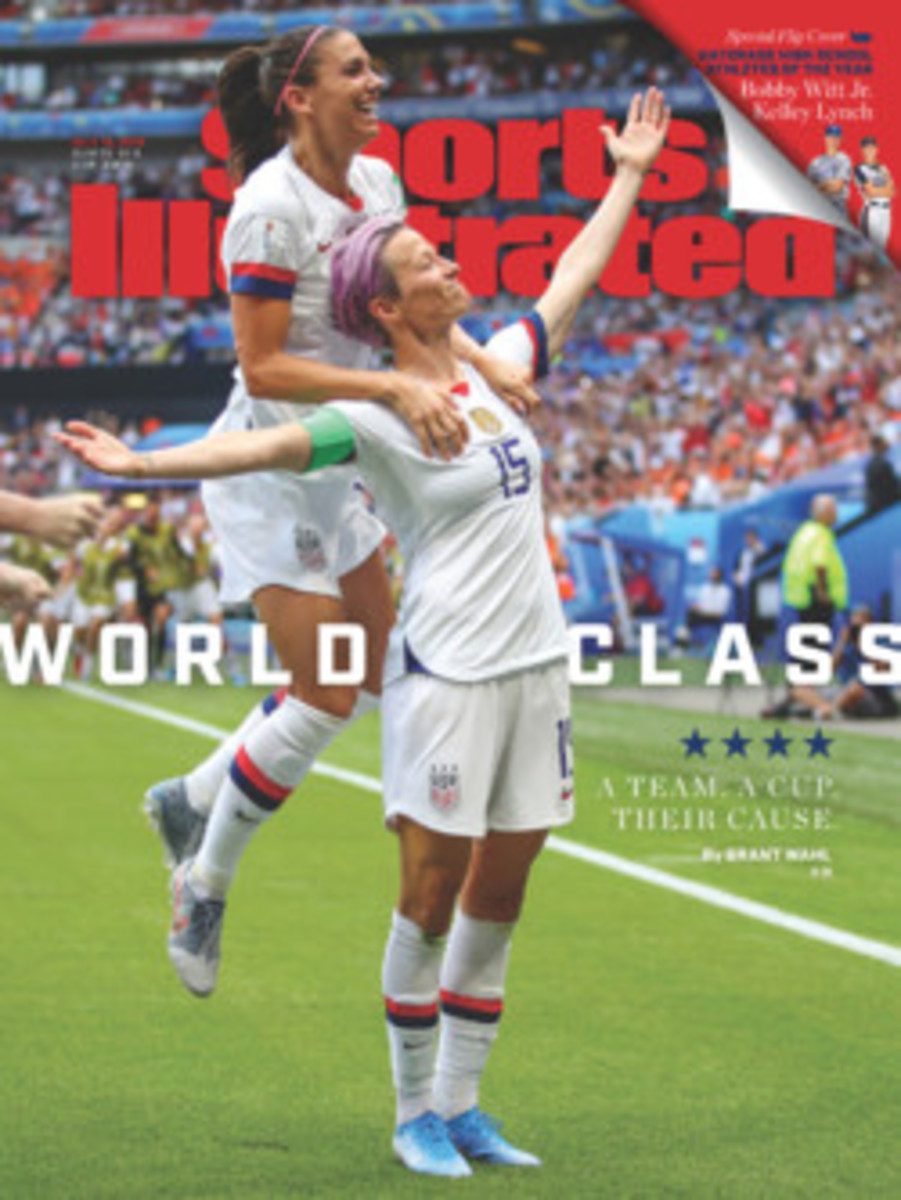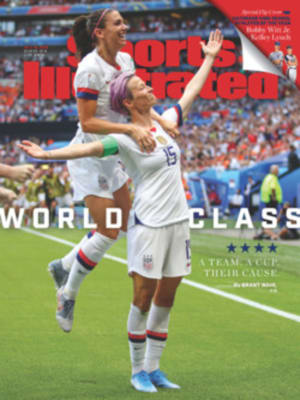
LOVE 15
What did you do on summer vacation? With power, patience and extraordinary stamina, 15-year-old phenomCOCO GAUFFhijacked Wimbledon's first week. This is only the beginning
LOVE-15 has taken on a new zest at Wimbledon this year. At age 37, Serena Williams arrived angling for her eighth title at the All England Club while Roger Federer, also 37, fixed his gaze on his ninth. Novak Djokovic (32) came with designs on defending his crown, while 32-year-old Andy Murray (Sir Andy Murray, to us), easing his way back from near retirement on account of a hip injury, came looking for a mixed doubles partner. He settled on Serena.
But, rich as they were, those story lines were driven into the shadows, thanks to a player who was sometimes younger than the ball kids ministering to her. Cori Gauff, d/b/a/Coco, a 15-year-old Floridian, simply hijacked Wimbledon's Week One. Equal parts ferocious and precocious, she won a series of matches on the grass, the rare adolescent who commanded adults to get off her lawn.
How did Gauff spend her summer vacation, the one, notionally, between her freshman and sophomore years of high school? She qualified for the main draw of Wimbledon, beat the mighty Venus Williams in her first match and won two more matches, including a classic on Centre Court. "My dreams are coming true," she gushed, never mind that said dreams were cultivated during the late Obama years. "I could lie and say it felt normal."
Gauff represents a three-way marriage of nature, nurture and inspiration. Her emergence is one of the many legacies of the Serena and Venus era: Gauff took to tennis in part because she grew up watching two champions who looked like her. She comes from good athletic stock, her father, Corey, having played D--I basketball at Georgia State while her mother, Candi, ran track at Florida State. By age eight, Gauff was winning national tournaments; at 13 she reached the final of the U.S. Open junior tournament, an event with an age limit of 18. By then she had sparked a bidding war among agents, and coaches were offering to pay her to use their services, so potentially valuable was the affiliation.
Last month Gauff was gifted a wild card into the Wimbledon pretournament qualifying event. She won her three matches without dropping a set, prompting one observer to send a text reading, "Coco Gauff is a top 20 player. Not potentially. Right now." In her first-round match at the All England Club, Gauff drew Venus, now 39, the five-time Wimbledon champ. Devoid of awe, Gauff won 6--4, 6--4. Finally, at the postmatch handshake, she massed the courage to express gratitude for all the Williams sisters had done.
To their credit, Gauff's parents attempted to apply a tourniquet to stanch the hype. Candi, a former teacher who homeschools her daughter, made Coco take a science test. (She got a B.) Corey, her coach, encouraged his daughter to stay off social media. She tried to comply by watching makeup tutorials on YouTube.
But when you're 15 and you're halving your ranking (No. 313 before the tournament; 139 after) and growing your Twitter following exponentially (17,000 before Wimbledon; almost 119,000 as of Monday), it makes for heady times. After beating Venus, Coco told herself, sensibly, she would enjoy the moment until midnight and then consider it a new day. Did she succeed? "Literally," she said, "I think I went to bed at 12:30 a.m.!"
Gauff followed up her defeat of Venus with another act of elder abuse, beating 30-year-old Magdalena Rybarikova, a Wimbledon semifinalist in 2017, 6--3, 6--3. By the time Gauff played her third-round match against Slovenia's Polona Hercog, 28, even the staid and measured Wimbledon decision makers realized the power of the narrative, and assigned the match to Centre Court. Fans who couldn't enter tennis's cathedral took to the grassy mound just outside, some standing on picnic tables to watch Gauff on the big screens. At home, 5.2 million viewers watched on the BBC. The next-highest-rated match of the first week, Rafael Nadal against the choleric Nick Kyrgios, drew 3.7 million.
Four other players in the Open era have reached the fourth round of a major before turning 16: Tracy Austin, Andrea Jaeger, Jennifer Capriati and Martina Hingis—all but Jaeger ended their careers in the Hall of Fame. But Gauff's breakthrough is more impressive, given that she is playing in an era that demands more physical maturity. (Tracy Austin was listed at 5'4" and 90 pounds when she won her first U.S. Open, as a 16-year-old in 1979; Gauff is 5'9".) "I have a feeling Coco Gauff will transcend the game," says Martina Navratilova, who broadcast the match for BBC. "She wants it, she lives it already. She was born to do this."
IT WAS not simply that Gauff was winning, but how. Just as there are baseball throwers and then there are pitchers, tennis has hitters and then it has players. Gauff is the latter. She can—and often does—hit the hell out of the ball, not least on her second serve, which can eclipse 100 mph. But she also plays with age-defying feel and nuance. You would never have guessed that this was her first grass-court pro tournament, given her patience and willingness to leaven her power with rhythm-shifting slices and cute angles. She also moves so well, it can look as though her half of the court is somehow smaller than her opponent's.
And Gauff showed will to match her skill. Against Hercog in her third-rounder, Gauff started slowly. Then, as if she found a charger right before her phone died, she blazed to life. Down match point at 2--5 in the second set, Gauff sliced a backhand that landed squarely on the line, triggering roars of delight from the crowd. She pushed the set to tiebreaker, won that and then, in a validation of her fitness, prevailed in a nearly three-hour match 3--6, 7--6, 7--5. "My life," she said, "changed in a matter of seconds."
She's right. But therein lies some concern. Tennis's various prodigy stories have not always ended happily. So much so that 25 years ago, the WTA implemented age-eligibility rules aimed at easing adolescents into the workforce and combatting the burnout encapsulated by Capriati. The rules restrict the number of tournaments players under age 18 can enter. (Between her 14th and 15th birthdays, a player can participate in eight pro events, for example.)
This has triggered a philosophical debate. Is this paternalism or responsibility? Should players with potential be able to realize it, unfettered? Or should there be guardrails in place? Sloane Stephens, a wise soul at age 26, was asked about Gauff last week. "I think she's a kid and she needs to be a kid.... It's very overwhelming at times," she said. "She's incredible. But she's also 15."
Federer, perhaps not surprisingly, takes a more free market approach. "I understand the rule completely that they want the young players not to play too much," he says. "[But] I've told the WTA they should loosen up the rules."
Gauff will let the adults figure out her schedule. She'll simply enjoy the moment, this collision of future and present. She's also not sweating how to spend the $220,000 in prize money she earned from her trip to London. "I mean, I can't buy a car because I can't drive," she added. "My mom, she bans me from buying hoodies for two months. I don't like spending money."
On Monday, Gauff played No. 7 seed Simona Halep, spotting her opponent 12 years in age and more than 300 ranking spots. Finally acting her age, Gauff fell quietly, 6--3, 6--3, the accumulation of attention and match play having caught up with her.
She may not play again until the U.S. Open. But she'll return to a sport that has gone cuckoo for Coco Gauff.
"I HAVE A FEELING GAUFF WILL TRANSCEND THE GAME," SAYS NAVRATILOVA. "SHE WAS BORN TO DO THIS."

